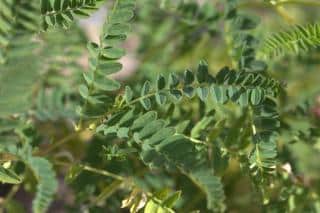

Native to Asia, mongolian milkvetch is a plant that grows in Northern China, in the Sichuan and Yunnan provinces. It also grows in other Asian pine wood forests, estuaries and river banks.
Known under the name “Huang qi” or “Huang zhi” in China, “Ogi” in Japan and “Hwanggi” in Korea, milkvetch parts used in herbal medicine are the roots. These are harvested in spring on a plant aged four to seven years old. They’re then dried before use.
Today, over 2,000 milkvetch species and cultivars are numbered, but that on which herbalists, scientists and laboratories have focused is the milkvetch native to China, Astragalus propinquus, which has long-documented health benefits recorded by botanists and pharmacology.
Milkvetch has been used in Traditional Chinese Medicine (TMC) for over 2000 years. It bestows various properties which can be considered in terms of benefits for health.
Which are these? How effective are these properties to benefit the human body? To what extent? Which precautions must be taken?
Here’s a quick overview…
Part of the Fabaceae family, milkvetch holds a particular place in the ranks of Traditional Chinese Medicine.
Indeed, the root part of this medicinal herb is used as a preventive remedy for some ailments, and also as a curative solution against others.

Following an epidemic of myocardia that shook the Chinese nation at the end of the 1980s, scientists discovered that this disease was caused by a virus called Coxsackie B.
In 1987, to eradicate this virus which was so dangerous to the heart’s muscles, Chinese researchers affirmed that a preparation based on milkvetch should be prescribed.
For preventive use, milkvetch root is recommended for respiratory disorders (both microbial and viral) and also to counter the overall weakening of the patient.
For curative use, mongolian milkvetch is used as an overall invigorating tonic: perfect to boost the immune system!
Milkvetch contains various active compounds, among which:
– flavonoids (which include astragalin, a powerful antioxidant),
– amino acids,
– triterpenoid glycosides (astragalosides I-VII),
– polysaccarides,
– and finally traces of minerals.
Thanks to the immune-boosting properties that is boasts, this plant native to China can:
– regulate the portion of lymphocytes (white blood cells) in the case of certain cancers. This particular property can increase the amount of antibodies circulating in the blood flow of healthy person.
– produce anti-inflammatory effects,
– protect liver cells against certain toxins.
From there, in medicinal practice, milkvetch root is used to prepare the traditional “Yu Ping Feng San” preparation. This is well-known in Chinese herbal medicine to treat repeat colds, the flu, chronic bronchitis and allergy-induced rhinitis.
Moreover, when used for its invigorating tonic activity, milkvetch is counseled in order to:
– stimulate appetite and the immune system in case of tiredness or recovering after a disease or operation,
– reinvigorate elderly persons, mothers suffering from post-partum depression and other forms of chronic diseases.
Among the most sought-after therapeutic benefits of milkvetch, this Asian plant:
– prevents upper respiratory tract infections, particularly for persons vulnerable to flu and colds.
– may even increase interferon levels. These are natural proteins produced by the immune system cells. These proteins stimulate the immune system and combat tumors and viral infections.
Depending on the ailment you wish to treat or prevent, milkvetch root is sold under various forms, to ingest as follows:
– for infusions, the daily dosage varies. To prepare it, bring ½ quart (½ liter) water to boiling. Toss in 3 to 6 tables spoons of dried and chopped root. Let it simmer for more or less ¼ hour before drinking. Drink ½ quart (½ liter) to 1 quart (1 liter) a day.
– as a tincture, ingesting 2 to 4 ml in the morning, at midday and in the evening covers the needs.
– for capsules, the usual dosage is 1 to 3 grams of powdered dried root per day. However, this depends on how the powder was produced and the type of ailment to treat.
– powdered root. Ingest 4 to 7 g of roots a day, divided into 2 or 3 doses.
Have you ever heard of milkvetch butter? It substitutes for walnut butter.
Did you know you could produce it yourself? Here is what you need to do:
In a bain-marie, warm 1 cup tahini and 7 tablespoons pumpkin seed paste. Add 3 tablespoons dried powdered milkvetch root and 3 tablespoons sesame oil.
Mix all of the above until a homogenous, smooth paste results. If the result isn’t soft enough, add up to 1 table spoon sesame oil. Mix again.
This milkvetch butter will keep for 15 days in the refrigerator.
Nota Bene: these ingredients are for sale in most organic lifestyle shops.
Milkvetch is often very well digested and induces no side effects.
However, it isn’t recommended for persons suffering of an acute infection, pregnant women and nursing mothers.
As for patients who suffer from an auto-immune disease and those who have recently received a transplant, it’s highly recommended to seek counsel with your consulting physician before using a plant that stimulates the immune system such as milkvetch.
Note that excess doses of milkvetch for extended periods of time (over 28 grams per day) may lead the patient to suffer from immunosuppressant effects.
Of course, in case of doubt, searching out the advice of a physician properly trained in Traditional Chinese Medicine is highly recommended.